The best (and strangest) tech coming in 2023
By Chris Velazco and Tatum Hunter
After a rising tide of coronavirus cases put the show at risk last year, CES – formerly known as the Consumer Electronics Show – is back in full swing.
Well, maybe not exactly full swing. The Consumer Technology Association, which stages the show in Las Vegas every year, says it expects about 100,000 attendees to walk through those convention centre doors this week. That’s more than twice the number of people who visited last year but still around 70,000 attendees shy of the last pre-pandemic show in 2020.
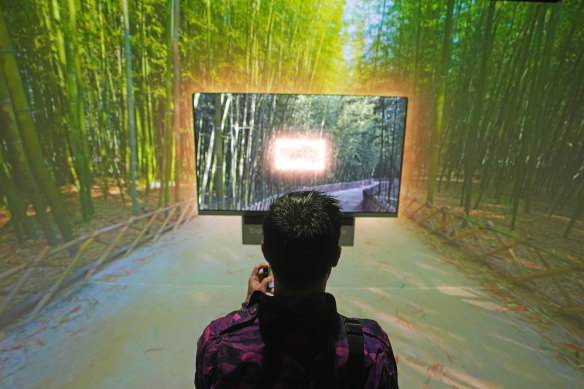
Still, CES is like a kaleidoscope of the new and strange. CES comes on the backdrop of a tough year for tech between widespread lay-offs, decades-high inflation and likely more regulation. Even so, big conglomerates, start-ups and everyone in between have come to Las Vegas to explain why their products are better than anyone else’s.
Because of that, it can be tough to tell which announcements – if any – are worth your attention.
This week, we’ll be in Las Vegas scouring the show floor for the best, most intriguing and downright weirdest products of CES 2023. (Fair warning: the early days will mostly be filled with the weird stuff.) By doing so, we hope to give you a better sense of how your relationship with the tech in your life stands to change over time – and hopefully give you something to chuckle at, too.
Here’s what we’ve found so far.
Smell your way through virtual worlds
If you’re anything like us, the first thought you had upon entering virtual reality was: I wish I could smell stuff in here.
OK, maybe not the very first thought. But according to Vermont-based start-up OVR Technology, adding scent to virtual experiences opens a new realm of possibilities for gamers, retailers and healthcare providers. At CES, it expanded on its existing offering – an add-on device for VR headsets – and dropped a stand-alone wearable with an odour-filled cartridge that pairs over Bluetooth with gaming systems, mobile devices or desktops.
Smell plays an important role in our limbic systems – which influence emotions and behaviour – so adding scent to a virtual retail exhibit or therapeutic VR environment can change the way people respond to it, OVR chief and co-founder Aaron Wisniewski said. In hospitals, for example, OVR’s tech is being tested to help burn victims manage pain. It’s also courting big retailers to add scent to at-home shopping or fancy marketing exhibits.

There are limits, of course. Lingering smells tend to blend into one another, so OVR must make its whiffs as short and distinct as possible, chief business officer Chris Scott said. And some smells don’t enhance the experience – does anyone want to smell blood in a shooting game?
We tried OVR’s headset accessory to learn what smell could add to a romp through VR. The virtual rose we plucked from the virtual ground smelled floral on one end and peaty on the other. An oceanside smelled like lavender. A waterfall was oddly vanilla-ish. OVR’s smell-a-verse isn’t elegant, but it’s the first iteration of something that might one day seem as natural as the scent of grass at a park.
Let your Samsung TV give you a check-up
Let’s be honest: sometimes successfully scheduling an appointment with a doctor feels like winning the lottery. To help, Samsung – yes, that’s Samsung – is trying to make it a little easier to get medical expertise in the moment.
As usual, the company showed up with a bevy of flashy televisions in tow, all of which can use a built-in Samsung telemedicine app to spell out symptoms and connect to a “relevant” doctor. (The camera, however, isn’t built-in, you’ll have to buy one separately.) The best part? Samsung claims you’ll generally be able to get a healthcare professional on the line in about 60 seconds, at which point you can unpack your concerns and sit through a handful of remote exams.

Once that’s done, the company says, you’ll have the option of scheduling a follow-up appointment and even getting a prescription filled remotely. If that all sounds just a little too convenient to be true, well, you may be right – pretty as they are, none of Samsung’s eye-catching TVs here in Las Vegas were connected to doctor’s offices or hospitals.
But what if you’d rather give yourself a check-up instead?
If you already bought a compatible camera, a new health monitor app will use it to peer at your face and measure vital signs such as heart rate, breaths per minute and blood oxygen saturation. This feature leans on a process called remote photoplethysmography, where software tracks minute colour changes on your face as you breathe and isn’t as kooky as it may sound. Still, there’s at least one possible catch here: this tech may not work equally well on everyone.
Analyse your pee at home
Your pee contains all sorts of clues about your health, but usually it takes a trip to the doctor to start decoding them. Withings, a “connected healthcare” company that makes smart scales and watches, is trying to solve this problem with a sensor inside your toilet.
The device, called U-SCAN, measures the make-up of your urine and delivers insights to an app on your phone. Two initial consumer versions, available soon in Europe, monitor nutrition and menstrual cycles, respectively, by tracking components such as vitamin C and hormone levels. The sensor looks like a palm-size white disk that sits under the front rim of the toilet bowl. (If you pee standing up, you’ll have to make some adjustments.) The company touts “changeable analysis cartridges”, so some rubber gloves might come in handy.
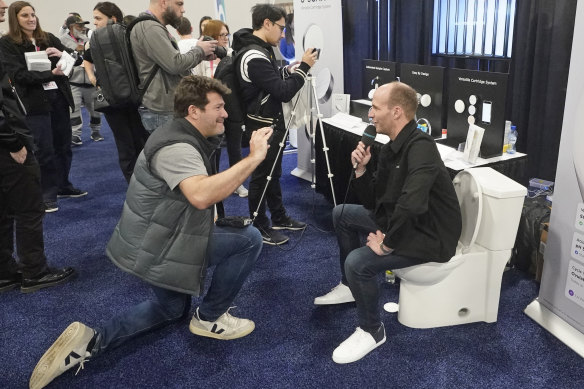
Beyond use at home, the device may also prove useful for medical professionals monitoring patients and conducting research. Withings says it can even help screen for bladder and ovarian cancer.
For obvious reasons, we didn’t test this one on the show floor. But with the ubiquity of health-tracking and sensors on your wrist, your finger and your bedside table, your toilet seems like the inevitable next frontier that companies will tout.
Start a party from your fridge
New refrigerators usually make for some of the least interesting reveals at CES, unless, like LG’s MoodUp fridge, they’re specifically designed to start a party.
For one, it changes colour to suit your mood for the moment – not to mention your next kitchen overhaul. Thanks to its LED-laden door panels and a handy smartphone app, owners can choose between 23 colour options for the top half of the fridge and 19 for the bottom. (Don’t worry, if the idea of all that mixing and matching is making you anxious, you can fire up a preloaded theme instead.)
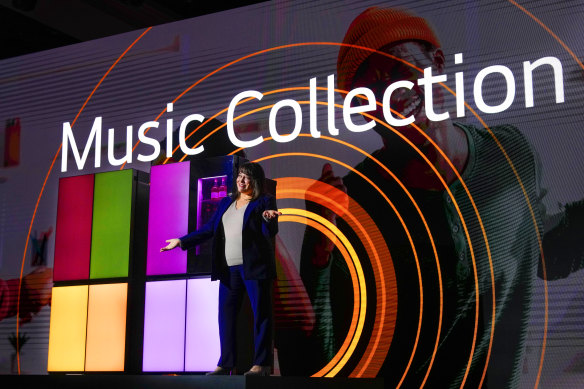
As if that weren’t enough, the MoodUp fridge also packs a built-in Bluetooth speaker for playing audio from connected gadgets nearby. Of course, it wouldn’t be a party without a light show, so the fridge’s LED panels can be set to change colours to the rhythm of whatever’s playing through the speaker.
This might all seem like some silly fun, and on some level, it is – but there really are some practical benefits on offer here. Our favourite: the fridge door panels will blink to let you know when they’re not fully closed.
Ease your anxiety with a pillow that ‘breathes’
Running around CES in search of the new and valuable can be pretty stressful. Thankfully, the Japanese robotics firm Yukai Engineering helped take the edge off by letting us cuddle with a soft, hefty prototype of a cushion called Fufuly that “breathes”.
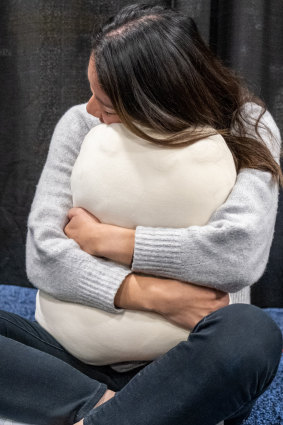
All right, it obviously isn’t breathing for real – instead, the pillow subtly expands and contracts to help it feel like it is. When the cushion transitions from its normal “breathing” state to a slower, deeper pattern mid-cuddle, the idea goes, your body will start to do the same. And as your sink into that relaxed cadence, your stress may well start to melt away.
So, how does it feel? If we’re being honest, it really was just a bit comforting, especially after a long day of traipsing around the Las Vegas Strip. (Your mileage, of course, may vary.)
If this sounds a touch familiar, it’s because the Japanese company that created Fufuly also developed Amagami Ham Ham, the finger-nibbling cat robot we found so delightful at last year’s show. And with any luck, Fufuly will become a real product just like its predecessor did – since launch, Yukai Engineering says it has sold about 30,000 nibbling animal robots in Japan.
Be fully present in the metaverse
When talking about the challenges of fully representing a person’s body in virtual spaces, Meta CEO Mark Zuckerberg once remarked that “legs are hard”. Turns out, not everyone seems to think so.
The solution, at least according to a Panasonic subsidiary called Shiftall, is a series of wireless sensors that strap to your chest, knees, hips and ankles that relay motion data to compatible Steam VR games running on a PC. The result: a way to make your in-game avatar move around just like you do, assuming you’re willing to shell out $US349 ($517).
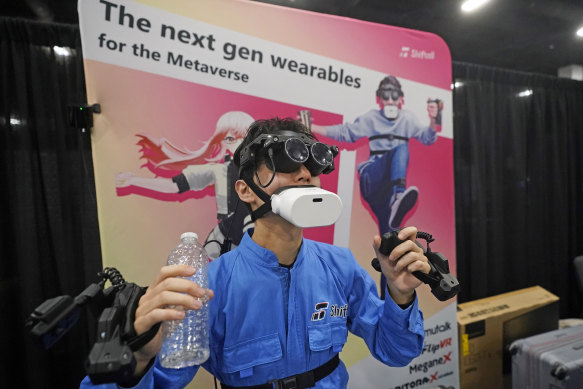
Turns out, those sensors are just the beginning. Shiftall also makes a product called the Mutalk, a rounded white box with a built-in microphone that straps over your mouth and prevents bystanders from hearing you chat with people in games and virtual spaces.
It looks, well, pretty ludicrous. But as the name suggests, it’s surprisingly good at muting loud sounds such as yelling, which means wearers can swear up a storm after losing a round in Fortnite – or try a little scream therapy – without raising too many eyebrows. (Seriously: Shiftall CEO Takuma Iwasa screamed in our faces and we barely heard a thing. It was pretty pleasant, all things considered.)
The Washington Post
The Business Briefing newsletter delivers major stories, exclusive coverage and expert opinion. Sign up to get it every weekday morning.
Most Viewed in Business
Source: Thanks smh.com